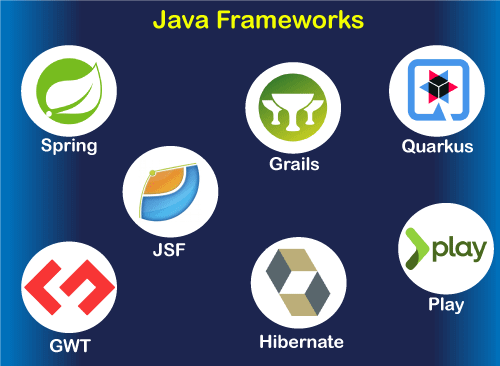What is Framework in JavaJava Framework is the body or platform of pre-written codes used by Java developers to develop Java applications or web applications. In other words, Java Framework is a collection of predefined classes and functions that is used to process input, manage hardware devices interacts with system software. It acts like a skeleton that helps the developer to develop an application by writing their own code. What is a framework?Framework are the bodies that contains the pre-written codes (classes and functions) in which we can add our code to overcome the problem. We can also say that frameworks use programmer's code because the framework is in control of the programmer. We can use the framework by calling its methods, inheritance, and supplying "callbacks", listeners, or other implementations of the Observer pattern. Popular Java FrameworksSome of the most popular Java frameworks are:

SpringIt is a light-weighted, powerful Java application development framework. It is used for JEE. Its other modules are Spring Security, Spring MVC, Spring Batch, Spring ORM, Spring Boot and Spring Cloud etc. Advantages
HibernateHibernate is ORM (Object-Relation Mapping) framework that allows us establish communication between Java programming language and the RDBMS. Advantages
GrailsIt is a dynamic framework created by using the Groovy programming language. It is an OOPs language. Its purpose is to enhance the productivity. The syntax of Grails is matched with Java and the code is compiled to JVM. It also works with Java, JEE, Spring and Hibernate. Advantages
PlayIt is a unique Java framework because it does not follow JEE standards. It follows MVC architecture pattern. It is used when we want to develop highly scalable Java application. Using Play framework, we can develop lightweight and web-friendly Java application for both mobile and desktop. Advantages
JavaServer FacesIt stands for JavaServer Faces. It is a component-based UI framework developed by Oracle that is used to build user interfaces for Java-based applications. It follows MVC design pattern. The application developed using JSF has an architecture that defines a distinction Advantages
Google Web Toolkit (GWT)It is an open-source framework that allows developers to write client-side Java code. With the help of GWT, we can rapidly develop complex browse application. The advantages to use GWT is that we can easily develop and debug Ajax application. the product of Google, such as Google AdSense, Blogger are developed using GWT. Advantages
QuarkusIt is a modern, full-stack, and Kubernetes-native Java framework. It offers small memory footprint and reduced boot time. It works well if the infrastructure is cloud-native. It optimizes Java specifically for Kubernetes and enables it to become an effective platform for serverless, cloud, and Kubernetes environments. Advantages
Advantages of Java FrameworksThe advantages of the Java Frameworks are as follows:
Examples of Frameworks in JavaIn Java, Collection is an example of the framework. It reduces the programming efforts because it provides useful data structure and algorithms. It is referred to as library that do not provides inversion of control. Another example of framework is, Swing and AWT classes. Swing is a GUI based framework used to develop windows-based application. It contains a large number of interfaces. There is inversion of control because of listeners. Framework vs. Library
Next TopicWhy Java is Secure
|
 For Videos Join Our Youtube Channel: Join Now
For Videos Join Our Youtube Channel: Join Now
Feedback
- Send your Feedback to [email protected]
Help Others, Please Share










